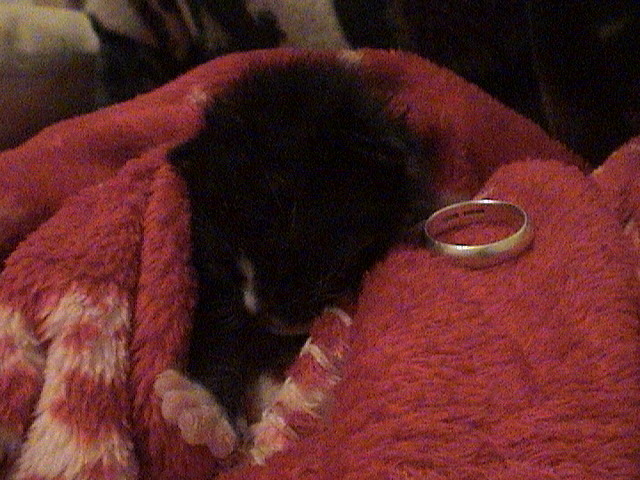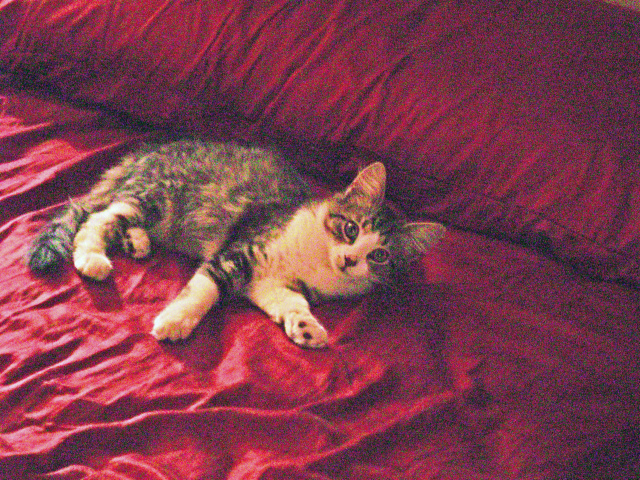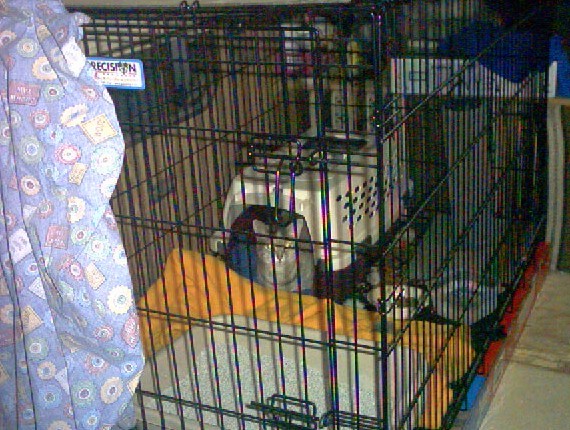QuestionQUESTION: Hi there. I have a question about my 2 year old female. She is not fixed. Callie is a very beautiful, spoiled little kitty lol. She went into heat last week, and while she was in heat, my neighbor brought over 2 kittens. Callie didnt react very well at all. For the last week, she has been very very nasty, which is not her. She is trying to attack our other cat which we have had for a year now. The vet said she could be sick. but these behaviors have only happeed since the other kittens were here. She wont even let me touch her without growling and hissing. I dont know what is wrong with her. Is it because she is not fixed, and she is very territorial? How long will she be like this?
ANSWER: Danielle,
It is important for you to realize that while the initial behavior may have been a territorial response it is quite possible that your vet may be right and Callie may be sick. There is a possibility that your cat may be suffering from a uterine infection, a vaginal infection, a bladder infection, stones in her bladder or urinary tract...It is in your cat's best interests to be examined by a vet as soon as possible and given the necessary treatment if she is ill. I would recommend that you take the opportunity to speak with your vet about the benefits of spaying your cat. I would also recommend that you have Callie spayed as soon as possible so that no further behavioral issues develop that could potentially be caused by hormones and territory. It is important that you realize that it isn't natural for Callie to cycle repeatedly without being bred and that breeding her will actually contribute more kittens to the serious pet overpopulation issue that may potentially end up in shelter systems and be euthanised. Unfortunately the current research suggests that repeated exposure of cats to sex hormones can cause severe health issues along with the many common behavioral issues that territorial/hormonal behaviors can cause. There is a very serious pet overpopulation crisis worldwide. All too often pregnant female cats, litters of kittens and intact male cats are admitted to animal shelters, abandoned or euthanised by private veterinarians for a variety of reasons including behavioral issues. Cats and kittens that enter shelter systems stand a good chance of being euthanised simply because time or space run out. Cats that are abandoned often die due to poisoning, animal cruelty, being attacked by a predator (raccoon, domestic dog, etc) or being hit by a car. Contrary to popular belief it isn't necessary for cats to have a litter prior to being spayed. Spaying and neutering are routine procedures that many vet clinics perform several times a day and although there is a risk with any anesthetic whether it be for a person or cat the risk is minimal, in fact many of the same drugs that are used to anesthetise a person are used in veterinary surgery. There are substantial medical and behavioral benefits to spaying and neutering. Cats that have been spayed or neutered are at a substantially decreased risk of developing infections in their reproductive system and mammary glands. Spaying and neutering also prevents cancer of the uterus, ovaries, prostate, and testicles and reduces the risk of tumors in the mammary glands (breast cancer). Cats that have been spayed or neutered are also less likely to need treatment for injuries sustained in a cat fight including abscesses which can require a general anesthetic to drain and a course of antibiotics to keep the infection under control and allow the wound to heal. Many behavioral issues can be prevented or minimized by spaying and neutering your cat. A spayed or neutered cat is less likely to become aggressive in defending territory. Biting and scratching of humans and other cats is usually substantially decreased. Cats that have been spayed or neutered are also far less likely to use urine or feces to mark their territory which is a common behavioral issue that leads to countless cats being euthanised each year. Spaying and neutering allows your pet to live a longer and healthier life while lowering the risks of terminal illness and serious behavioral issues as well as preventing unplanned litters of kittens that would contribute to the overwhelming and serious pet overpopulation crisis...Please help prevent unwanted kittens or severe health and behavioral issues, spay your kitty. Ultimately, it is quite possible that if you opt not to spay your kitty she may remain like this. I hope that this information helps. If you have any further questions or concerns or, you would simply like to send an update or some pictures my way, please don't hesitate to contact me again.
---------- FOLLOW-UP ----------
QUESTION: Thank you very much for the info above. I am going to try to get her fixed ASAP! Why I am writing back is because, I think Ive found why she is so cranky. There is a large sore in her ear. It has gotten worse over the last week. Someone mentioned it could be hemotoma? It almost looks like cauliflower ear. I dont have a whole lot of money, will it cost alot to get it fixed?
AnswerDanielle,
What you are describing could possibly be a hematoma which is essentially a bruise that has filled with blood. These issues can be the result of earmites or fleas so there is a good possibility that your vet may have to prescribe medicine to remove the parasites. Your cat may also have an ear infection which is important to treat as soon as possible because damage can occur to the ear if the underlying issue doesn't get treated promptly. No matter what the underlying cause for this issue you should be aware that your cat is somewhat uncomfortable and she should be treated as soon as possible to alleviate her discomfort and improve her disposition. I am not sure what part of the world you are in. If you are in Canada or the US some SPCA shelters will provide routine or emergency medical care either at a reduced rate or free of charge depending on your financial circumstances through a program called SPCA Cares. In the UK there are Blue Cross Animal Hospitals that will provide care at a reduced rate or free of charge and are able to do so due to the generosity of public donations. It is quite possible that your vet may be willing to work out a payment plan for repairing your cat's ear and spaying her. There may be a non profit vet clinic that will spay your cat and deal with her ear in exchange for volunteer time spent cleaning cages or feeding any hospitalized animals. You won't know what resources are available unless you ask around. I do hope that you find this information helpful. If you have any further questions or concerns, or you would simply like to send some pictures or an update my way, please don't hesitate to contact me again.

 Orphaned Kitten
QuestionQUESTION: My partner and l are very much animal
Orphaned Kitten
QuestionQUESTION: My partner and l are very much animal
 Cats Fighting
Question
Big Cat
Hello.i have a cat named lucky.he is a
Cats Fighting
Question
Big Cat
Hello.i have a cat named lucky.he is a
 One month old Kitten
Question
The one month old, aka
I have tried bef
One month old Kitten
Question
The one month old, aka
I have tried bef
 Additional info about the possbile norwegian
Question
Edmund at 4 months
I forgot to mention. Edmund
Additional info about the possbile norwegian
Question
Edmund at 4 months
I forgot to mention. Edmund
 vacation house and taking cat
Questionour permanent home is on a 3 acre semi wooded p
vacation house and taking cat
Questionour permanent home is on a 3 acre semi wooded p